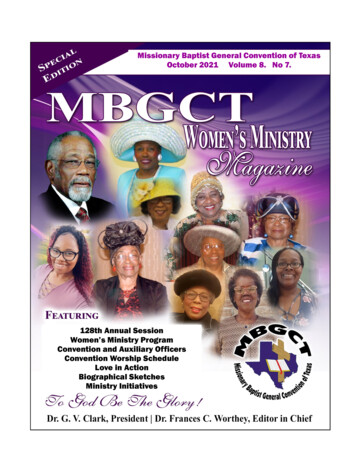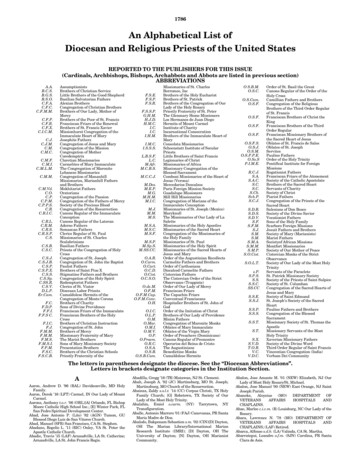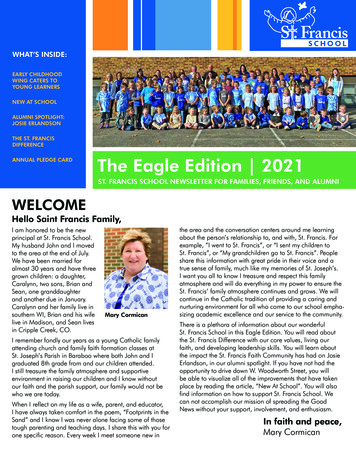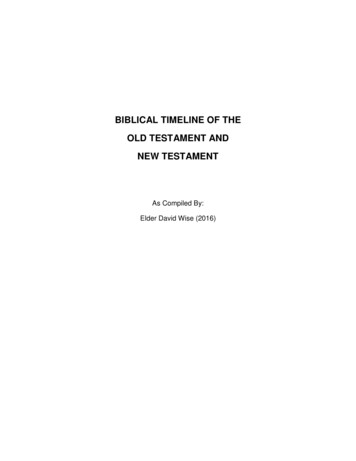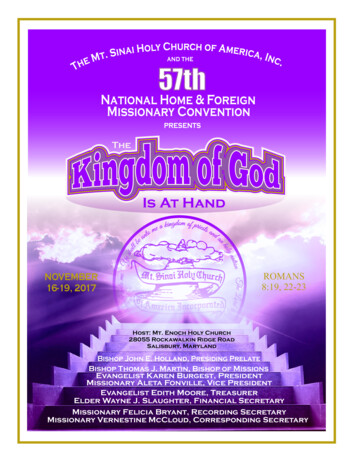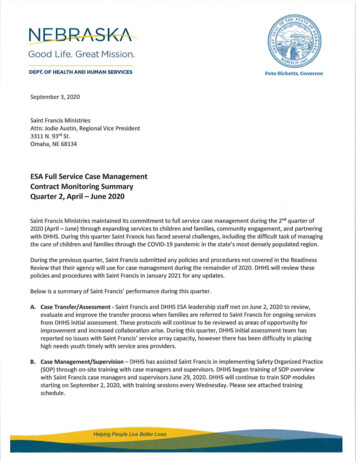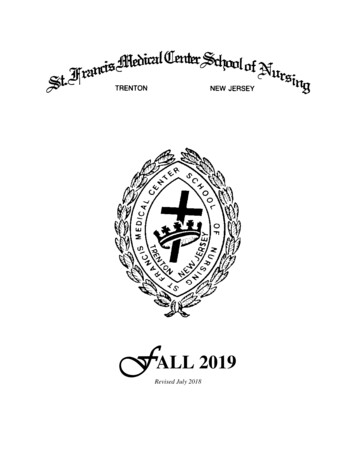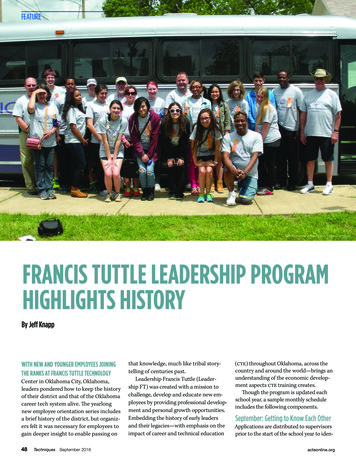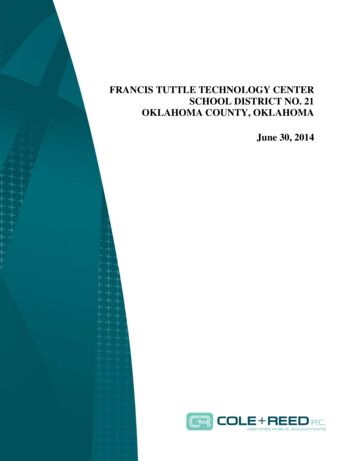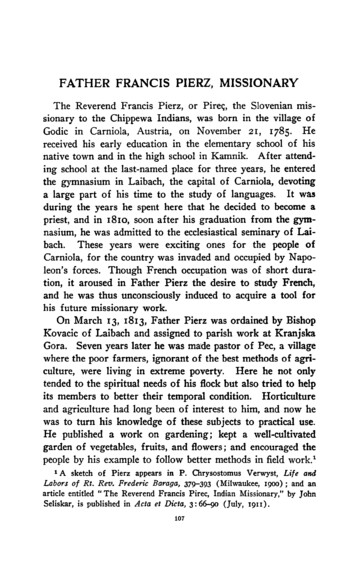
Transcription
FATHER FRANCIS PIERZ, MISSIONARYThe Reverend Francis Pierz, or Pire?, the Slovenian missionary to the Chippewa Indians, was born in the village ofGodic in Carniola, Austria, on November 21, 1785. Hereceived his early education in the elementary school of hisnative town and in the high school in Kamnik. After attending school at the last-named place for three years, he enteredthe gymnasium in Laibach, the capital of Carniola, devotinga large part of his time to the study of languages. It wasduring the years he spent here that he decided to become apriest, and in 1810, soon after his graduation from the gymnasium, he was admitted to the ecclesiastical seminary of Laibach. These years were exciting ones for the people ofCarniola, for the country was invaded and occupied by Napoleon's forces. Though French occupation was of short duration, it aroused in Father Pierz the desire to study French,and he was thus unconsciously induced to acquire a tool forhis future missionary work.On March 13, 1813, Father Pierz was ordained by BishopKovacic of Laibach and assigned to parish work at KranjskaGora. Seven years later he was made pastor of Pec, a villagewhere the poor farmers, ignorant of the best methods of agriculture, were living in extreme poverty. Here he not onlytended to the spiritual needs of his flock but also tried to helpits members to better their temporal condition. Horticultureand agriculture had long been of interest to him, and now hewas to turn his knowledge of these subjects to practical use.He published a work on gardening; kept a well-cultivatedgarden of vegetables, fruits, and flowers; and encouraged thepeople by his example to follow better methods in field work. * A sketch of Pierz appears in P. Qirysostomus Verwyst, Life andLabors of Rt. Rev. Frederic Baraga, 379-393 (Milwaukee, 1900) ; and anarticle entitled " The Reverend Francis Pirec, Indian Missionary," by JohnSeliskar, is published in Acta et Dicta, 3:66-90 (July, 1911).107
io8SISTER GRACE MCDONALDJUNEFrom Pec he went to Podbrizje, where he worked for fiveyears. In 1830 the Reverend Frederic Baraga, the missionary,visited him at this place and tried to induce him to leave hiswork in Europe, where there was no dearth of priests, and toreturn with him to America to labor among the Indians.'Father Pierz, however, did not respond favorably to the invition of the missionary, for his heart was with his poor peopleat Podbrizje. He was, moreover, forty-five years of age andfelt that it was too late to learn the difficult Indian language.Baraga, however, saw that Father Pierz had the qualitiesneeded by a missionary — the ability to master languages, aknowledge of agriculture, love of open-air life, a strong constitution, patience with the slow and untutored, and a zeal forsouls. It was this last characteristic of Father Pierz's onwhich Baraga worked to win him for the missionary field.The letters that the priest received from Baraga after the latter's return to America pictured so vividly the deplorable condition of the pagan Indian, the great work to be accomplished,and the small number of workers in the field that, after hesitating for five years, Father Pierz finally succumbed to hisfriend's entreaties to devote himself to the American Indian.After leaving Carniola on June 16, 1835, Father Pierz wentto Vienna and obtained funds for his transportation from theLeopoldine Society.* From Vienna he traveled to Le Havre,2 Seliskar, in Acta et Dicta, 3:69. Baraga was an Illyrian priest whowent to Arbre Croche, the present Harbor Springs, Michigan, in 1831.He worked at Grand River, La Pointe, Fond du Lac, and L'Anse. In 1836his sister, Antonia de Hoeffern, joined him as a teacher at La Pointe. Helater became bishop of Sault Ste. Marie.3 This organization, which was known in Austria as the LeopoldinenStiftung, was founded in Vienna in 1829 for the purpose of supportingthe struggling American missions. In 1831 it began the publication, underthe title of Berichte der LeopoldinenStiftung im, Kaiserthume Oesterreich,of annual reports on the condition of the missions in the various Americandioceses. These consist mainly of the letters and official reports of themissionary priests and bishops in America to the officers of the society. Anearly complete set of the Berichte is owned by the Minnesota HistoricalSociety; another file is in the library of St. John's University at Collegeville.
1929FATHERFRANCISPIERZ109France, whence he sailed for America. In a letter to theLeopoldine Society, dated May i, 1836, he reports:I arrived on September 18 at Detroit, the chief city of MichiganTerritory, where the Very Reverend Bishop gave me a fatherlywelcome; and I soon received, along with a very extensive jurisdiction, the welcome order to journey across Lake Superior toFather Baraga, for the purpose of working . . . with myfellow countryman, that tireless missionary, for the conversion ofthe heathen in the farthest area of this diocese. On account of thelateness of the season and the approach of winter no ship was ableto cross the lake, so I returned to Michigan Territory, to La Croix,a sub-mission of Arbre Croche, for the winter, where I have beenhappily engaged in pastoral duties for five months.*The next spring Pierz expected to start for his original destination. Fond du Lac, but Bishop Frederic Rese, pleased withthe success of the new worker, detained him at the post of.La Croix. Nevertheless, his stay at this place was short, forin August of the next year the crops were destroyed by frostand the Indians scattered through the woods, thus breaking upthe school established in 1836 and leaving Father Pierz without a congregation. He was then transferred to Sault Ste.Marie, where he found awaiting him four hundred ChristianFrench, Indians, and half-breeds who had fallen into disorderlyliving and had been without the attention of a pastor for manymonths. His work here was hard and at times his discouragement was so great that if the winter had not set in he wouldhave given up the mission. Compelled to remain, he workedto the best of his ability. In the midst of this work of revivalof faith he found time in the spring and fall of 1837 to visitsome pagans dwelling to the north of Lake Superior at St.Joseph and at Kitchimitigong. His first journey was a failure,as he himself relates, but the second was successful, probablybecause it was made on the invitation of the chief, who came* Berichte, 10:43. Franz Pierz, Die Indianer in Nord-Amerika; irhe Lebensweise, Sitten,Gebr'duche u.s.w., 63 (St. Louis, 1855).
noSISTER GRACE MCDONALDJUNEto him in person and begged instruction for himself and hispeople.'In June, 1838, he started out on a missionary trip to Michipicoten and Okwanikisinong to the north, where he hadheard that many pagans lived. In a letter to the LeopoldineSociety he described Michipicoten as a small village on a beautiful plateau near the mouth of a large river of the same nameand on a bay of Lake Superior. The depot stationed herebelonged to an English trading company whose agent treatedthe Indians well and never ruined them with liquor. Thismade it easier, according to the missionary, to plant the seedof Christianity. After instructing and baptizing twenty-fivenatives, he traveled to Okwanikisinong, a large pagan settlement forty-five miles farther north. Here a group of seventeen received Christianity and were baptized on the picturesqueshore of the lake. Though he gained these converts. FatherPierz did not think it feasible to erect a church here, becausethe Indians at this place traveled about so much and becausehe had no funds. When his provisions gave out he was forcedto return to Sault Ste. Marie. Such trips were a drain on hissmall pocketbook, for his sailor and guide cost him " twelveflorins daily besides food of bacon, biscuits, and tea." He wasnot to remain long at the Sault, for he received a letter fromBaraga telling him to visit Grand Portage and to open up amission there during the simimer, with a substation at FortWilliam. Upon reaching Grand Portage Pierz found the way somewhat paved for him by a half-breed woman, Mrs. Pierre Cotte,who had prepared many for baptism. A small log chapel hadbeen constructed in anticipation of his coming and he found Berichte, 12: 76; Pierz's baptismal register, June 9, 1837, in the possession of the St. Paul Seminary, St. Paul. The Minnesota HistoricalSociety has a photostatic copy of the register. St. Joseph is an island inGeorgian Bay near the shore of Ontario.''Berichte, 12:80-85; Pierz's baptismal register, June 17, 21, 1838.Michipicoten was a trading station near the north shore of Lake Superior.
1929FATHER FRANCIS PIERZinthe natives so kindly disposed to Christianity that he stayedwith them until March of the next year. During this periodhe also established missions at Fort William and Pic. Betweenthe time of his arrival at Grand Portage and the end of theyear, fifty-four natives were Christianized. One hundred andfive is the number registered for the whole year.' His schoolat Grand Portage was attended by fifty-eight Indians andseventeen French pupils, who were taught reading, writing,and agriculture. While on a visit to one of these villages inthe fall of 1839 Pierz received orders from Bishop PeterLe fevre to leave this rich field and return to Arbre Croche toattend the Ottawa.* This meant for Pierz not only a strenuous and dangerous trip of six hundred miles late in the season,but the sacrifice of the good already accomplished. He excusedthe bishop for this apparently harsh order by stating that hissuperior did not realize the hardships of the trip. " This moveof the bishop's was not made because of any lack of ability onthe part of Father Pierz, but rather because the territory inwhich his missions were located would come under the jurisdiction of the proposed diocese of Milwaukee and BishopLefevre was simply withdrawing his men into his own field.Father Pierz obediently set out in the cold stormy seasonon a trip of fifty-four days, arriving safely at Arbre Crocheon December 3, 1839, after suffering many hardships. * Thismission was to be his field of work for the next thirteen years.He was never to restrict his work to Arbre Croche mission,however, for it was not large enough to satisfy his energy.At every opportunity he was off to visit his former missions,8 Pierz's baptismal register, July 29, 1838, to May 19, 1839; Pierz,Indianer, 70-73. For an account of the history and importance of GrandPortage see Solon J. Buck, " The Story of the Grand Portage," ante,5:14-27. The Right Reverend Peter Lefevre was consecrated coadjutor ofDetroit in 1841 and acted as administrator of the affairs of the diocese ofDetroit from that time until 1843." Pierz, Indianer, 76. 1 Pierz, Indianer, 77-81.
112SISTERGRACE MCDONALDJUNEparticularly Grand Portage and Fort William. In the fall of1842 he was again working at the outlying missions when hisbishop sent word that he must leave these places and remain athis main station of Arbre Croche and, obedient to authority,he returned to that mission. From this place he took care ofSault Ste. Marie, Middleton, and La Croix; and in 1844Cheboygan and Manistee were added to his list of missions."In a letter of 1843 Father Pierz thus describes his work atArbre Croche and in the surrounding country:In summer I spend my time mostly in traveling to distant substations of this mission or in converting the heathen; in winter Iteach school. All my spare time is spent in writing in the Indianlanguage, for we have at present only two little books written inthis tongue by Bishop Baraga. . . .At present I am trying tocomplete a larger cathechism . . . and seventy sermons inthe Indian tongue for Sundays and feast days. . . .I amwont to give some attention to gardening and to agriculturebecause I have not only to teach the Indians religion but also apractical economy, which will advance their temporal and eternalwelfare. In order to civilize them I must myself often showthem the use of the sickle, scythe, plow, and flail."Upon arriving at a village Pierz would first call on the chief.After the salutation and greeting were given the chief wouldbe presented with tobacco and his squaw with needles, thread,or a handkerchief. After thus winning the good will of the" first family " of the village, the missionary would explainto the chief the purpose of his visit and, if the chief was willing, the braves were called for a conference or a smoker, asthe priest called it. When this ceremony was over the missionary was asked by the chief to address the assembly andthis " was done in a soft tone of voice, with short pauses andin simple terms." The missionary then left the natives todiscuss the affair by themselves. If they resolved to listen tohim he set a time for instruction to adults in the morning andevening and for the children in the forenoon and afternoon. 'Berichte, 17:53; Metropolitan Catholic Almanac, 1844, p. 93. Berichte, 17:57.
1929FATHER FRANCIS PIERZ113After sufficient instruction had been given the class was baptized and the missionary went off to other fields. But beforeleaving his new converts, the missionary always appointed areliable and exemplary man to lead services on Sunday and toconduct school during his absence. This system bore fruit, forby the year 1841 heathenism was wiped out at La Croix. *Accepting Christianity was a great hardship to many Indianwomen and children, for polygamy was not permitted toChristians and many women consequently found themselveswithout homes. The missionary found it necessary to supplythem with homes where they could be trained to help themselves. D. P. Bushnell, subagent at La Pointe, reported in1839 that Father Pierz had established a school at GrandPortage, which was attended by fifty-eight Indian and seventeen French pupils, and that they were given courses in reading and writing. Middleton, La Croix, Arbre Croche, andTraverse Bay had schools under this missionary's care. In1836 the La Croix school had an attendance of thirty-twopupils and Arbre Croche in 1845 li d as many as two hundred.In general the subjects taught in these schools were plain sewing, knitting, spelling, reading, writing, and arithmetic. "This work of civilizing and instructing was ineffective aslong as the Indian continued to roam about, living on the huntalone and changing his abode with the season. These Indianhabits disrupted classes, and agriculture could not be followedup by people who continued to live a nomad life. FatherPierz tried to persuade the natives to build homes, hoping thatthis would keep them closer to him. But unless he could assurethem enough food by means other than hunting, he realizedthat he would find it impossible to induce them to live in oneplace. He therefore taught the Indians to prepare the soil andto sow and reap crops. In the vicinity of Arbre Croche he'* Pierz, Indianer, 91-93; Berichte, 15:64.1 Pierz, Indianer, yi; N. H. Winchell, The Aborigines of Minnesota,640 (St. Paul, 1911) ; Metropolitan Catholic Almanac, 1844, p. 93;Berichte, 10: 44; United States Indian Office, Reports, 1849, p. 203.
114SISTER GRACE MCDONALDJUNEprocured two thousand acres of land from the government foragricultural purposes, and in six years he had most of theIndians there living in neat houses and getting their food fromthe products of the fields and the returns from the fish andmaple sugar industries. By the year 1847 his converts hadcleared seven inclosures, were selling half of their grain to thewhite settlers of the vicinity, and had shipped to other partsten thousand measures of potatoes in one year. Those livingat Arbre Croche alone in a single year sold four hundred barrels of fish and eight thousand pounds of sugar. *In this work Pierz had to contend not only with the natureof the Indian but also with the opposition of the fur-trader.It was to the advantage of the latter to keep the Indian poorand uncivilized so that he might have no other resource thanhunting. Thus he would continue to bring in furs for themarket. Father Pierz declared that the traders did much toprejudice the natives against the Christian faith and that they" put all possible obstacles in the way of the missionary, aiming to retard as long as possible the agricultural training of theIndians in favor of their own sordid interests." "Another obstacle to be overcome by the missionary was theliquor evil. To suppress this was one of his hardest problems,for he had to deal not only with the Indian and the trader butwith the half-breed. The traders used liquor to facilitatetheir trade in pelts, but the half-breed liquor trafficker wasmore dangerous, for his concoction was of a fouler and morepoisonous sort. Moreover, he would follow the individualIndian even to his trapping grounds, and there, after a goodpile of pelts was gathered, would induce the hunter to drink.Thereupon the half-breed would abscond with the pelts. In a18 Berichte, 22:97; Indian Office, Reports, 1846, in 29 Congress, 2 session, House Executive Documents, no. 4, p. 262 (serial 497) ; 1847, in30 Congress, i session, House Executive Documents, no. 8, p. Sao(serial 515)." Berichte, 15: 71.
1929FATHER FRANCIS PJERZ115letter written in February, 1854, to Bishop Cretin of St. Paul,Father Pierz complained that within three days after the government pay day all the provisions, blankets, and money givenout by the government were in the hands of these whiskyagents. Within a month there was much sickness and suffering from lack of food and from the cold, for the natives hadmissed the fishing and planting season and the fall hunting.The liquor business must have been profitable to those engagedin it, if the prices quoted by Father Pierz are accurate. Hementions the sale of one bottle of whisky for twenty dollarsand two gallons of brew for forty dollars, and tells that atanother time for fifty blankets an Indian was given two gallons of so-called liquor made up of tobacco juice, water, andsome whisky. *Father Pierz often acted as physician for the unfortunateIndians. He was a strong believer in homeopathy and treatedmany sick among the pagans as well as among the Christians,thus breaking down prejudice and bringing to him many whootherwise would not have come near him. During the smallpox epidemic of 1846, which struck several northwestern bandswith destruction, the doctor of the Mackinac region was himself sick and unable to answer Father Pierz's call for help.The missionary sent for vaccine and administered it tonine hundred individuals, giving himself no rest or care,though he was then in his sixtieth year.**All this was done without the assistance of an Americanmissionary society and without the help of the United Statesgovernment. Pierz did appeal to the govemment for a smallpittance of a teacher's salary, but the request was not heeded.The Leopoldine Society of Vienna and the Ludwig Mission18 Pierz, Indianer, 87; Annalen der Verbreitung des Glaubens, 32:171.A file of this publication, which consists of the reports of missionariessent out by the Ludwig-Missionsverein, a Bavarian organization similar tothe LeopoldinenStiftung, is in the library of St. John's University.19 Berichte, 21:71; Indian Office, Reports, 1847, in 30 Congress, i session, House Executive Documents, no. i, p. 910 (serial 5x5).
Ii6SISTER GRACE MCDONALDJUNKSociety of Bavaria listened to his appeals and responded to thebest of their ability, but the amount given to Pierz was smallin comparison with the sums expended by the United Statesgovernment and the Protestants through the American Boardof Commissioners for Foreign Missions.'"'Pierz's missionary trips were the greatest drain on hismeager resources, as he tells in a letter written in 1841.The Indian missionary must enter upon his difiicuh and dangerousjourney through forests, without road or path, over streams andlakes, which he crosses in birch-bark canoes. Around manyobstructions to navigation the canoe must be carried on theshoulders — a work for which French-Canadians are used. Thesehelpers must be given not only three portions of bacon, bread, andtea daily, but also at least one dollar per person. The interpretermust be paid twice this sum as his daily fee. Therefore the costof such a missionary journey, with at least four men companionsand the indispensable interpreter, comes to more than twentyflorins daily and increases to a higher fee if the mission workrequires many days or some months.* Despite the cost and hardships of such journeys, FatherPierz traveled over a thousand miles each year. He preferredsuch rough work, however, to labor in a semicivilized field.His work was not with Christians, but rather with pagans; andas soon as the greater number of the inhabitants of a villagewere converted, he left them to plant the seed of Christianityin other places. He felt it was possible to get priests to carryon the work he had started, but that missionaries to the paganswere scarce. This spirit of restlessness under the restraintof life in a well-ordered community and the feeling of impatience with the slow progress of the converts began to showitself anew in 1847, " '* was increased later in the year whenon a visit to Father Otto Skolla, the Fransciscan missionaryat La Pointe, Pierz met some Chippewa Indians from theMississippi River. Berichte, 15:66.21 Berichte, 15 : 69.
1929FATHER FRANCIS PIERZ117In 1851 the diocese of St. Paul was organized, and the Chippewa of Minnesota came under the care of the head of thatdiocese. Bishop Joseph Cretin. He knew of Father Pierz'ssuccess as a missionary and asked him to join the new dioceseand work among the Indians. Pierz was only too glad to acceptthe invitation, and with the consent of his bishop he handedover his missions to his two assistants and started for St. Paul,reaching there on June 18, 1852. " In view of the shortage ofpriests in this new diocese, Pierz was also authorized tominister to the white settlers scattered along the MississippiRiver for a hundred miles. Thus Indians, half-breeds,traders, and land-seekers were the elements composing his newflock. The missionary arrived at Crow Wing on July 20 incompany with a trader named Beaulieu, who had traveled fiftymiles to meet him. This trader feared that the missionary'sfirst impression of the Indians at Crow Wing would not bevery favorable, for they were having a war dance at the time;but no doubt this news only made the seasoned missionarymore anxious to reach his post of duty. That fall and winterhe spent at Crow Wing, and he built a church and school onthe spot where he saw the war dance at the time of his entranceinto the settlement.''* In the spring and summer of 1853 and1854 he sought out the white settlers along the MississippiRiver at Sauk Rapids, Swan River, and Belle Prairie andorganized parishes at each place, and in the latter year hevisited the German settlements at St. Cloud and St. Joseph.As soon as possible he left the settlers and returned to his22 Pierz, Indianer, 84.2' A baptismal register kept by Father Pierz from 1852 on opens withthe statement that the Crow Wing mission was established on August I.The original is in the parish house at Belle Prairie, Minnesota; the Minnesota Historical Society has a photostatic copy.2* A paper in the Pierz collection at the St. Paul Seminary, datedAugust 9, 1852, shows that Captain John B. S. Todd, the commandant atFort Ripley, gave Father Pierz permission to occupy any piece of land notexceeding twenty acres in size for church purposes.
ii8SISTER GRACE MCDONALDJUNEIndians, visiting for the first time in 1853 those at Mille Lacsand Sandy Lake.**The journey from Crow Wing to Mille Lacs, which wasone of the hardest trips he ever made, Pierz describes as follows :Two-thirds of the distance was made on foot over poor roadsthrough brush and timber and one-third was made by water. Wecrossed six lakes in a birch-bark canoe weighing two hundredpounds, which my cathechist had to carry on his shoulders whencrossing portages. My cook carried the kitchen utensils and foodweighing about a hundred and fifty pounds. My burden was thewhole portative chapel with the articles needed for mass and thebooks, as well as blankets weighing seventy pounds. . . It is impossible to travel on horseback in summerbecause the road Hes through five deep, dirty swamps and overthousands of fallen trees and execrable hunters' trails. For twodays we traveled amid indescribable hardships. On such awretched way I often stumbled over roots and I once had suchan unfortunate fall that I was obliged to remain where I fell forsome time until I was rested and could rise. . . .The worst feature of this trip was the fact that in my hastydeparture I forgot my mosquito netting and my gloves and fortwo days I had to keep waving a leafy branch about my head tokeep off the never-ceasing swarms of mosquitoes. In this processmy hands were tortured. Nevertheless I was so badly stungabout the face and on the hands by bold attackers that I sufferedas much pain from the bites as if I had a severe case of nettlerash.At the close of the second day we came so close to the Indianvillage that we could see their wigwams. Our attention beingtaken away from the canoe for a moment, it struck a tree in thewater and we had to land at once and spend the night in a swamp.*"Father Pierz had hitherto dreaded the coming of settlersamong the Indians, but by this time he saw that they would havethe land sooner or later; and, since the transition was inevitable, he wanted God-fearing men to come and have the advantage of free lands. Therefore he added to his many activitiesthat of prospector and "booster" for Minnesota. Though" Pierz's baptismal register. 1853-44. 'i Pierz, Indianer, 89. See also Berichte, 26: 57.
1929FATHERFRANCISPIERZ119his prospectus entitled " Eine kurse Beschreibung des Minnesota-Territoriums," published for the purpose of making Minnesota better known to the Germans in the United States andabroad, may at times seem somewhat exaggerated, probablyfew of those who were persuaded to come were disappointedafter settling in the state. As a result of this sketch and similar articles that Father Pierz published, fifty families took upland at St. Joseph and Jacob's Prairie. It is safe to say thatthe majority of settlements established in Steams County during the late fifties are the result of Pierz's advertising of thissection among the Germans.*' Having been instrumental inbringing these settlers to the region, it devolved upon him toattend to their religious needs. Thus Father Pierz was thefounder of the Catholic parishes of Sauk Rapids, Swan River,and Belle Prairie in 1853; of St. Cloud and St. Joseph in1854; and of St. Augusta in 1855. It is true that these parishes were visited by the missionary but two or three times ayear, much to the disappointment of the settlers. In hisarticles about the region Pierz stated that churches had alreadybeen built at Sauk Rapids, St. Joseph, and St. Cloud — areport that gave readers the impression that these places hadpastors.** Father Pierz was now seventy years of age andhis work instead of growing lighter was, because of the influxof settlers, growing too heavy for one man, especially an oldman. At his suggestion. Bishop Cretin asked the Benedictinefathers of Pennsylvania to attend to the German settlers ofthis part of the diocese.*'2T The prospectus is printed in Pierz, Indianer, 117-130. The authorrelates that similar material had been published in the Wahrheits-Freund,a Catholic weekly newspaper published in Cincinnati. An incomplete fileof this paper is in the library of St. John's University, but the issuesthat contain Pierz's advertising are missing. Pierz's sister's family wasamong the first to settle at St. Joseph. A district in Wakefield Township,Stearns County, is known locally as Jacob's Prairie.28 Pierz, Indianer, 128.2* See August C. Krey, " Monte Cassino, Metten, and Minnesota," ante,8:223-225.
120SISTER GRACE MCDONALDJUNEThe arrival of the Benedictines in the summer of 1856allowed Father Pierz to give all his attention to his Indianmissions of Crow Wing, Mille Lacs, Fond du Lac, and SandyLake. Indeed they needed his whole attention, for the Chippewa, Sioux, and Winnebago Indians were continually fighting. Their feuds were constantly interfering with the missionary's work of civilization and sorely tried his patience andability as a peace-maker. In 1858 Father Lawrence Lautischarwas sent to assist Father Pierz, and together they establisheda mission at Red Lake on August i. After spending twomonths here. Father Pierz left his assistant to continue thework, giving him strict instructions to attempt no journeysduring the winter, but to spend the time in teaching school atthe mission house. The veteran missionary retained for himself the dangerous task of long winter trips. But on December10, while he was at Belle Prairie, a messenger brought thenews that Father Lautischar had frozen to death while returning from a sick call to a heathen Indian living across the lake.Ordinarily a man of seventy-three would have given up at thispoint, but not so the old missionary. He even refused an invitation from Father Augustin Ravoux, administrator of thediocese, to go to St. Paul for a well earned rest. "Father Pierz felt that he now had double work to perform,and in February, 1859, he visited Leech Lake, his newest mission, making the trip of eighty miles in three days. For twomonths he worked strenuously at this place, giving instruction to children and adults. He found these Indians trueto his high appraisement of Chippewa ability, for in threeweeks the members of his class were ready to receive baptism.In fact he felt that he had never succeeded so well anywhereelse. His success he attributed first to the fact that the Indians30 Annalen der Verbreitung des Glaubens, 27:388; Father AugustinRavoux to the Assoc
tion of the missionary, for his heart was with his poor people at Podbrizje. He was, moreover, forty-five years of age and felt that it was too late to learn the difficult Indian language. Baraga, however, saw that Father Pierz had the qualities needed by a missionary — the ability to master languages, a
